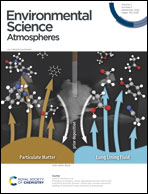Elucidating the impacts of COVID-19 lockdown on air quality and ozone chemical characteristics in India†
Abstract
India implemented a stay-at-home order (i.e. lockdown) on 24 March 2020 to decrease the spread of novel COVID-19, which reduced air pollutant emissions in different sectors. The Weather Research and Forecasting model with Chemistry (WRF-Chem) was used to better understand the processes controlling the changes in PM2.5 and ozone in northern India during the lockdown period, including (1) the contributions of inter-annual variability in meteorology and emissions (dust, biogenic, and biomass burning) and lockdown emissions to changes in PM2.5 and ozone in northern India and (2) to analyze changes in ozone production regimes due to the lockdown. We found that both meteorology and lockdown emissions contributed to daytime PM2.5 (−12% and −12%, respectively) and ozone (−8% and −5%, respectively) reduction averaged in April 2020 in the Indo-Gangetic Plain, and in smaller magnitudes in northern India. However, the ozone concentration response to reductions in its precursors (i.e. NO2 and VOCs) due to the lockdown emissions was not constant over the domain. While the ozone concentration decreased in most parts of the domain, it occasionally increased in major cities like Delhi and in regions with many power plants. We utilized the reaction rate information in WRF-Chem to study the ozone chemistry. We found carbon monoxide, formaldehyde, isoprene, acetaldehyde, and ethylene as the major VOCs that contribute to the ozone formation in India. We used the ratio of radical termination from radical–radical interactions to radical–NOx interactions, and its corresponding formaldehyde to NO2 ratio (FNR) to find the ozone chemical regimes. We showed that the FNR transition range in a region depends on whether it is an urban, rural, or power plant region. Using the FNR information, we found that most parts of India are within the NOx-limited regime. We also found that large emission reduction during the lockdown period shifted the chemical regimes toward NOx-limited although it did not necessarily change the chemical regime in many VOC-limited regions. The results of this study highlight the fact that reducing the exposure to both PM2.5 and ozone requires air pollution management strategies that consider both NOx and VOC emission reductions, and that take into account regional characteristics.

- This article is part of the themed collection: The role of tropospheric ozone in atmospheric processes, health and climate - Topic Highlight


 Please wait while we load your content...
Please wait while we load your content...